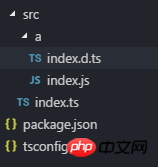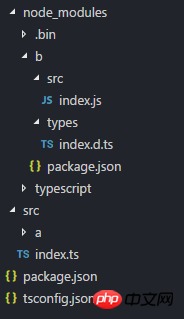Detailed explanation of the use of js bundled TypeScript declaration
This time I will bring you a detailed explanation of the use of js bundled TypeScript declaration. What are the precautions for js bundled TypeScript declaration. The following is a practical case, let's take a look.
Preface
TypeScript is a superset of the JavaScript type. This is a sentence introduced in the TypeScript documentation. So are they connected?
My understanding is that TypeScript introduces the characteristics of a strongly typed language based on JavaScript. Developers use TypeScript syntax for programming development, and finally convert TypeScript into JavaScript through conversion tools.
Using TypeScript can avoid the pitfalls of weakly typed languages caused by developing on native JavaScript. (What should I enter? What should I return after the call? Let’s take a look at the source code...)
Hmm! Very good, strongly typed JavaScript, very good. However, I can’t bear the meticulous humanistic care of many libraries in NPM o(TヘTo)
Don’t be afraid, many libraries now quietly support TypeScript. Even if they have no intention of supporting it, there are still big guys who make selfless contributions. Quietly help these libraries support TypeScript
This leads to the topic of this article, the TypeScript declaration file. I think it is a header file for the JavaScript library similar to the C language. Its existence is to help TypeScript introduce the JavaScript library.
What is a declaration file?
is very similar to C/C *.h header files: when you reference a third-party library (.lib/.dll/ .so/.a/.la), the C/C compiler cannot automatically recognize the exported names and function type signatures in the library, which requires the use of header files for interface declarations.
Similarly, the TypeScript declaration file is a TypeScript code file with the .d.ts suffix, but its role is to describe the type information of all exported interfaces within a JavaScript module (in a broad sense).
For the writing and specifications of TypeScript declaration files, please refer to the following official documents and excellent blog posts:
https://www.tslang. cn/docs/handbook/declaration-files/introduction.html
http://www.jb51.net/article/138217.htm
According to the official documentation, there are the following two bundling methods:
Bundled with your npm package
Publish to npm The @types organization
is bundled with the npm package as mentioned above. Developers can use it directly after npm install a library in the ts project and import it in the code file.
When some libraries are not officially maintained, you can use the second method. After npm installs a library, execute npm install @types/library name to install the declaration file of the library. The principle is that after TypeScript version 2.0, when you import a library and the specified library is not found in the configured include path, it will look for the library in @types of node_modules.
Generally speaking, the official recommendation is the first way to write the release statement document. Let me directly use an example to demonstrate the first bundling method.
Example
First initialize the TypeScript project, The directory structure is as follows:

tsconfig.json configuration is as follows:
{
"compilerOptions": {
"target": "es5",
/* Specify ECMAScript target version: 'ES3' (default), 'ES5', 'ES2015', 'ES2016', 'ES2017', or 'ESNEXT'. */
"module": "commonjs",
/* Specify module code generation: 'none', commonjs', 'amd', 'system', 'umd', 'es2015', or 'ESNext'. */
"allowJs": true,
"outDir": "./dist",
/* Redirect output structure to the directory. */
/* Allow javascript files to be compiled. */
"strict": true /* Enable all strict type-checking options. */
},
"include": [
"src/**/*"
]
}As you can see, I wrote a module a and bundled a declaration file with it. The content of module a, that is, src/a/index.js is as follows :
const NAME = 'A';
let call = (who) => {
console.log('Hello ' + who + '! I am ' + NAME);
}
export default {
call
}The declaration file is src/a/index.d.ts and the content is as follows:
declare namespace a {
function call(who: string): void;
}
export default a;At this time, we can enter the entry file src/index. ts introduces a module:
import a from './a';
a.call('Pwcong');After executing tsc on the command line, js code can be generated in the directory dist:

Execute the command node ./dist/index .js can get the corresponding correct output.
We then simulate importing the released NPM library, create directory b under the node_modules directory, and initialize the Node project. At this time, the directory structure is as follows:

其中 node_modules/b/types/package.json 内容如下:
{
"name": "b",
"version": "1.0.0",
"main": "./src/index.js",
"types": "./types/index.d.ts"
}node_modules/b/src/index.js 内容如下:
const NAME = 'B';
let call = (who) => {
console.log('Hello ' + who + '! I am ' + NAME);
}
module.exports = {
call
}声明文件 node_modules/b/types/index.d.ts 内容如下:
declare namespace b {
function call(who: string): void;
}
export = b;这时,我们修改 src/index.ts :
import a from './a';
a.call('Pwcong');
import b = require('b');
b.call('Pwcong');命令行执行 tsc 后即可在目录 dist 中生成js代码后执行命令 node ./dist/index.js 也可以得到相应正确的输出。
相信看了本文案例你已经掌握了方法,更多精彩请关注php中文网其它相关文章!
推荐阅读:
The above is the detailed content of Detailed explanation of the use of js bundled TypeScript declaration. For more information, please follow other related articles on the PHP Chinese website!

Hot AI Tools

Undresser.AI Undress
AI-powered app for creating realistic nude photos

AI Clothes Remover
Online AI tool for removing clothes from photos.

Undress AI Tool
Undress images for free

Clothoff.io
AI clothes remover

Video Face Swap
Swap faces in any video effortlessly with our completely free AI face swap tool!

Hot Article

Hot Tools

Notepad++7.3.1
Easy-to-use and free code editor

SublimeText3 Chinese version
Chinese version, very easy to use

Zend Studio 13.0.1
Powerful PHP integrated development environment

Dreamweaver CS6
Visual web development tools

SublimeText3 Mac version
God-level code editing software (SublimeText3)

Hot Topics
 Detailed explanation of obtaining administrator rights in Win11
Mar 08, 2024 pm 03:06 PM
Detailed explanation of obtaining administrator rights in Win11
Mar 08, 2024 pm 03:06 PM
Windows operating system is one of the most popular operating systems in the world, and its new version Win11 has attracted much attention. In the Win11 system, obtaining administrator rights is an important operation. Administrator rights allow users to perform more operations and settings on the system. This article will introduce in detail how to obtain administrator permissions in Win11 system and how to effectively manage permissions. In the Win11 system, administrator rights are divided into two types: local administrator and domain administrator. A local administrator has full administrative rights to the local computer
 Detailed explanation of division operation in Oracle SQL
Mar 10, 2024 am 09:51 AM
Detailed explanation of division operation in Oracle SQL
Mar 10, 2024 am 09:51 AM
Detailed explanation of division operation in OracleSQL In OracleSQL, division operation is a common and important mathematical operation, used to calculate the result of dividing two numbers. Division is often used in database queries, so understanding the division operation and its usage in OracleSQL is one of the essential skills for database developers. This article will discuss the relevant knowledge of division operations in OracleSQL in detail and provide specific code examples for readers' reference. 1. Division operation in OracleSQL
 Detailed explanation of the role and usage of PHP modulo operator
Mar 19, 2024 pm 04:33 PM
Detailed explanation of the role and usage of PHP modulo operator
Mar 19, 2024 pm 04:33 PM
The modulo operator (%) in PHP is used to obtain the remainder of the division of two numbers. In this article, we will discuss the role and usage of the modulo operator in detail, and provide specific code examples to help readers better understand. 1. The role of the modulo operator In mathematics, when we divide an integer by another integer, we get a quotient and a remainder. For example, when we divide 10 by 3, the quotient is 3 and the remainder is 1. The modulo operator is used to obtain this remainder. 2. Usage of the modulo operator In PHP, use the % symbol to represent the modulus
 Detailed explanation of the linux system call system() function
Feb 22, 2024 pm 08:21 PM
Detailed explanation of the linux system call system() function
Feb 22, 2024 pm 08:21 PM
Detailed explanation of Linux system call system() function System call is a very important part of the Linux operating system. It provides a way to interact with the system kernel. Among them, the system() function is one of the commonly used system call functions. This article will introduce the use of the system() function in detail and provide corresponding code examples. Basic Concepts of System Calls System calls are a way for user programs to interact with the operating system kernel. User programs request the operating system by calling system call functions
 Detailed explanation of Linux curl command
Feb 21, 2024 pm 10:33 PM
Detailed explanation of Linux curl command
Feb 21, 2024 pm 10:33 PM
Detailed explanation of Linux's curl command Summary: curl is a powerful command line tool used for data communication with the server. This article will introduce the basic usage of the curl command and provide actual code examples to help readers better understand and apply the command. 1. What is curl? curl is a command line tool used to send and receive various network requests. It supports multiple protocols, such as HTTP, FTP, TELNET, etc., and provides rich functions, such as file upload, file download, data transmission, proxy
 Learn more about Promise.resolve()
Feb 18, 2024 pm 07:13 PM
Learn more about Promise.resolve()
Feb 18, 2024 pm 07:13 PM
Detailed explanation of Promise.resolve() requires specific code examples. Promise is a mechanism in JavaScript for handling asynchronous operations. In actual development, it is often necessary to handle some asynchronous tasks that need to be executed in sequence, and the Promise.resolve() method is used to return a Promise object that has been fulfilled. Promise.resolve() is a static method of the Promise class, which accepts a
 Detailed analysis of C language learning route
Feb 18, 2024 am 10:38 AM
Detailed analysis of C language learning route
Feb 18, 2024 am 10:38 AM
As a programming language widely used in the field of software development, C language is the first choice for many beginner programmers. Learning C language can not only help us establish the basic knowledge of programming, but also improve our problem-solving and thinking abilities. This article will introduce in detail a C language learning roadmap to help beginners better plan their learning process. 1. Learn basic grammar Before starting to learn C language, we first need to understand the basic grammar rules of C language. This includes variables and data types, operators, control statements (such as if statements,
 A Deep Dive into Recursive Algorithms in C#
Feb 19, 2024 pm 08:09 PM
A Deep Dive into Recursive Algorithms in C#
Feb 19, 2024 pm 08:09 PM
Detailed explanation of C#'s recursive algorithm, specific code examples are needed 1. What is a recursive algorithm? Recursion is when a function or method calls itself during execution. Recursive algorithms are a common problem-solving method in programming. It decomposes a problem into one or more sub-problems that are similar to the original problem but smaller in size, and then solves the original problem by solving these sub-problems. Recursive algorithms are often used to solve repetitive problems. 2. How to implement recursive algorithms In C#, there are two main ways to implement recursive algorithms: direct recursion and indirect recursion. straight






